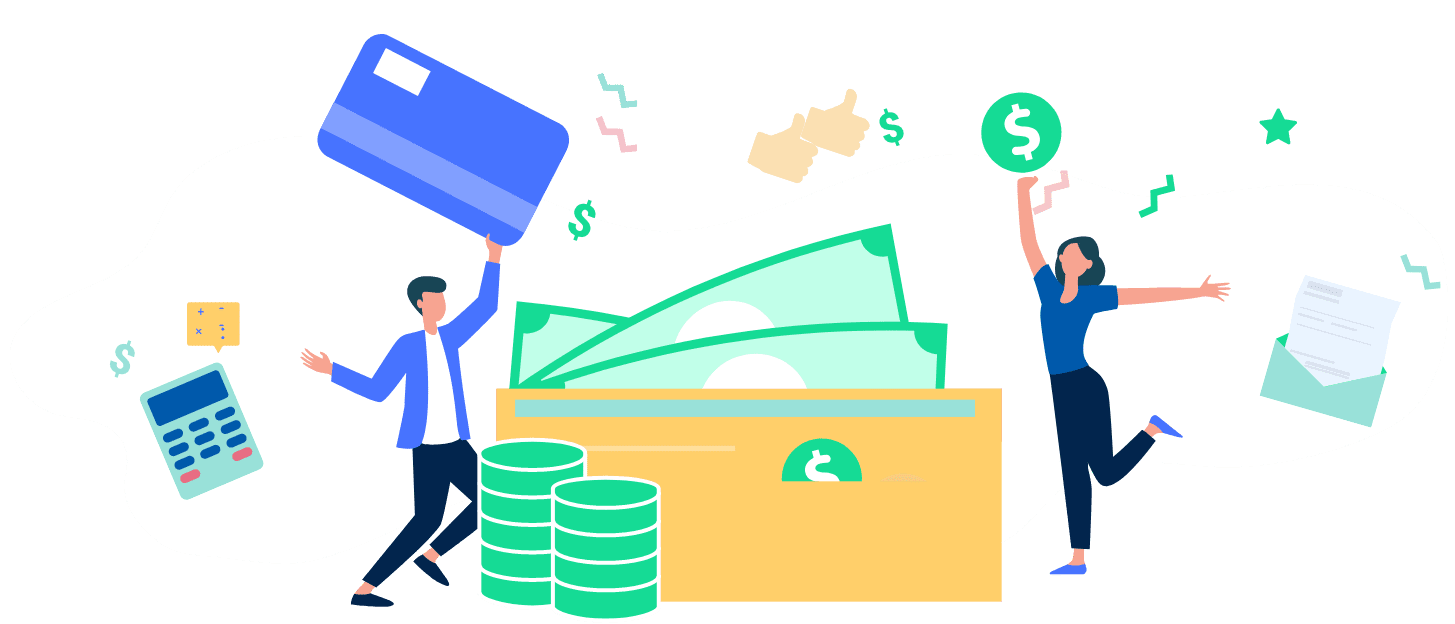If you need a small amount of cash fast to help finance an urgent need, a small personal loan can be a safe, easy, and less expensive option compared to other alternatives. However, as you consider your small loan options, be sure to weigh the advantages and disadvantages and find a lender that offers the best interest rates and terms.
What are small personal loans?
If you need quick cash to cover a medical bill, car repair, or other emergent or unexpected expense, a small personal loan might be a good option. These loans typically have amounts of $2,500 or lower, ranging from about $1,000 to $5,000 on average. Other unsecured small personal loans can be as small as $500.
Unlike personal loans, which can max out up to $100,000, these loans are for smaller needs and are typically paid back within two or three years, making the monthly payment relatively low. Interest rates can also be low if you have excellent credit, making these loans more affordable.
Small personal loans are:
- Unsecured, which means you do not have to put up collateral to be approved.
- Paid back over a short period of time.
- More affordable, with low interest rates for borrowers with excellent credit.
- Quicker and easier to get, with most of the processes happening online.
How do small personal loans work?
Small personal loans work just as a regular personal loan would, except their loan amount is smaller. A lump sum of funds are lent to you by a bank, credit union, or online lender. You can then use those funds for just about any reason you want. Then, you’ll pay the loan back in installments, or designated payments, each month over time. Those funds will also accrue interest, so you’ll have to pay that back as well.
Related: How do personal loans work?
How do I use small personal loans?
Like personal loans, small personal loans can be used for just about anything, such as paying for:
Medical bills
A wedding
Car repairs
A vacation
Home repairs
Where to get small personal loans
The best places to explore getting a small personal loan are credit unions, banks, or online lenders.
1. Credit unions, which were built to help their members, consider other factors beyond your credit score to help determine whether you qualify for a loan and what your interest rate will be.
2. Not all banks offer personal loans, and those that do typically stick to larger personal loans. However, you’ll find that Bank of America and U.S. Bank allow customers to borrow smaller amounts, even as low as $100. The downside is that criteria to qualify may include being an existing customer or having a high credit score. They also charge higher fees.
3. Online lenders work with borrowers who have ranging credit scores and needs. You may find that online lenders also offer more flexibility with the loan amount, and lower interest rates. These lenders also likely offer the fastest approval and funding process, most of which happen online.
Types of small personal loans
There are different types of small personal loans out there, including some to avoid. Those that you should compare include:
1. Unsecured vs. secured:
Unsecured loans don’t require collateral to qualify, while secured loans do. Collateral can be an asset such as a vehicle or savings account. If you have poor credit, you may want to explore secured loans as they are easier to qualify for and may have lower interest rates.
Learn more: Secured vs. Unsecured Personal Loans
2. Fixed vs. variable interest:
Fixed interest means the interest does not change over the life of the loan, and each monthly payment is the same. Variable interest can change from month-to-month, making budgeting more difficult and you could end up paying more depending on the interest rate you qualify for.
Related: Types of Personal Loans
Who are small personal loans best for?
Small personal loans are best for someone who needs a smaller amount of funding to finance a need such as a medical bill, car or home repair, emergency expense, or other smaller expense. In order to get the best interest rates, it’s important for borrowers to have great to excellent credit (at least 680+) and have a steady income that is enough to cover the monthly payments.
If you don’t think you’ll be able to afford the monthly payments, you don’t have a credit score that will qualify you for lower interest rates, or there are alternatives that are better options for you, a small personal loan may not be best for you.
How do small personal loans affect your credit?
There are a few ways a small personal loan can impact your credit score:
- When you apply for a loan, it triggers a hard credit inquiry. This will decrease your score by a few points, though the decrease should quickly recover and will only remain on your history for two years.
- Getting approved for a loan increases your debt-to-income ratio, which could decrease your score.
- Making late or missing payments can decrease your score.
- Defaulting on the loan can drastically impact your credit score.
On the other hand, making the monthly payments on time each month can help increase your score.
Pros and cons of small personal loans
Pros
Fast funding: Once approved, most lenders can deposit funds into your account within one business day.
Fixed payments: These loans are easy to budget since monthly payments are fixed and repaid over a set period of time.
Fixed interest rates: Most of the time, small personal loans have fixed interest rates, which means they do not change over the life of the loan.
Unsecured: No collateral is required to get the loan, so you will not be risking losing an asset if you default.
Cons
Minimum loan amounts: You may have trouble finding a personal loan for less than $1,000, so taking one out for a small expense may not be worth it.
High APR: Unless you have excellent credit, it may be difficult to qualify for a low interest rate, and they can be as high as 35%.
Credit checks: Those with poor credit may have a difficult time getting approved for a small personal loan altogether.
Penalties and fees: Some lenders charge extra fees for small loans, or prepayment penalties if you pay off the loan prior to the full term.
Alternatives to small personal loans
When you get a loan, you’re taking on additional debt. This increases your credit utilization and debt-to-income ratio, which can decrease your credit score. You’re also paying more over the life of the loan due to interest. Sometimes, a loan may be the best option. However, there are some alternatives to consider:
Borrow from a friend or family member you trust, and who trusts you to repay what you borrow.
Start a side hustle, pick up a second job, or work extra shifts at your current job to earn extra income on the side.
Create a budget, cutting out as many unnecessary expenses as you can and putting that money in savings, or toward other expenses.
Seek assistance from local nonprofits, charities, or religious organizations that may help those in need with things like bills, gas, groceries, or clothes.
Related: Need to Borrow Money?
What’s the difference between small personal loans vs. credit cards?
Using a credit card is relatively similar to using funds from a small personal loan. You have a credit limit on the credit card and can spend up to that amount, and then repay the card issuer (lender) each month. It’s best practice to pay off the balance in full, but it’s typically only required to make the minimum payment. You’ll accrue interest on any balance carried from month to month.
Small personal loans are funded by banks, credit unions, or online lenders, and you receive all of the funds up front. You can then use those funds for whatever you want, but you must repay the loan plus interest in monthly installments.
The biggest difference between credit cards and small personal loans is that with credit cards, the amount you can borrow is revolving, so you can borrow up to a certain limit each month but if you pay off the balance, you can borrow that much again the next month. Personal loan funds are finite, and once you get the funds, you don’t get any more.
The other difference is that credit card interest rates are typically much higher than personal loan rates. However, some cards have perks like 0% introductory APR, or cash back earning possibilities.
Both credit cards and small personal loans can impact your credit score.
Related: Personal loans vs. credit cards
Small personal loans vs. payday loans
A payday loan is also a type of small loan, but they are not recommended except in extreme circumstances. When you get a payday loan, you work with an independent lender to get a loan against your next paycheck, similar to an advance. These amounts are typically capped around $500, but your credit score and history is not impacted. Then, you have a very short period of time – often two weeks – to repay the loan.
The biggest downside is that the APR on payday loans can reach 400% or more. And, there are often several fees, so the total cost of the loan can add up quickly.
Small personal loan APR can range from around 5% to about 36%, but typically doesn’t go higher than that even if you have bad credit. Their amounts are also a little more flexible, as are the terms.
Small personal loans for bad credit
Even if your credit isn’t great (629 or below) you can still qualify for a small personal loan. Your best chance to do so would be through a credit union or online lender that tailors to borrowers with bad credit. However, keep in mind your interest rate will likely be much higher.
To improve your chances of qualifying for a loan, you can:
Work to improve your credit score by making all bill and loan payments on time, lowering your credit utilization ratio, and decreasing your debt-to-income ratio.
Review your credit report to ensure there aren’t any errors that should be fixed.
Add a cosigner to your loan.
Add collateral via a secured loan, such as a car.
Pros and cons of small personal loans for bad credit
| Pros | Cons |
|---|---|
Loans to avoid include
Payday loans:
These loans let you borrow a small sum of money until your next paycheck. However, these loans have extremely high interest (even up to 400% or more) and also have many fees.
Pawn shop loans:
With this loan, you’d put something of value (such as jewelry or art) at a pawn shop to act as collateral for a loan. These rates and fees may not be as high, but they are still much higher than personal loans. You’re also risking losing your collateral if you don’t repay the loan in time.
Car title loan:
This loan requires you to use your vehicle as collateral, but they have extremely high interest rates and fees. Plus, if you don’t repay the loan, you could lose your vehicle.
How to compare small personal loan lenders
There are several things you can compare when shopping for small personal loan lenders. Pay attention to factors like:
Interest rates:
Borrowers with lower credit scores may be charged higher interest rates, but it varies from lender to lender.
Repayment Terms:
Repayment terms can vary but reputable lenders give you between at least a few months and up to a few years to repay a small loan.
Loan amounts:
Many lenders don’t do smaller loans under $600, so you may need a different option. We’ll cover that in our “alternatives” section below.
Fees:
Check the origination fees and any monthly charges you’ll incur during the life of the loan. Use those as a comparison point between lenders.
A few additional things to keep in mind:
- Longer terms mean smaller monthly payments, but it also means you’ll accrue more in interest and end up paying more over time. Shorter terms have higher monthly payments but you’ll owe less over time.
- Compare the loan’s minimum requirements, like minimum credit score or income, to make sure you qualify before applying.
- Get prequalified for the loan. It won’t affect your credit score, but can give you a more personalized estimate of the loan amount, term, APR, and monthly payment you’d qualify for.
How to get a small personal loan
If you’ve determined a small personal loan is the best option for your financial situation, there are a few steps to getting one:
- Review your credit. You’ll qualify for better interest rates and loan terms if you have a higher credit score (690 or above). Check your score and if it needs improvement, take some steps to do so prior to applying for a loan. Also look at your credit utilization and debt-to-income ratio, which lenders may look at when determining whether you qualify.
- Do your research. With so many options out there, you’ll want to make sure to research and compare different lenders. Look carefully at loan amounts available, interest rates, terms, fees, and other loan features to find the best one for you.
- Prequalify. When possible, prequalify for a loan. This triggers a soft credit check, which doesn’t affect your credit score, and can show you a personalized estimate of monthly payments and interest rates you would qualify for. This can help you compare your options.
- Apply. When you’re ready, you can apply for the loan. Most applications will ask for things like your name, address, place of employment, Social Security Number, and other personal information. They also may ask for proof or documentation such as W-2s or pay stubs. Most of the time, applications can be done online.
- Accept the loan terms. If you are approved, the lender will send you the loan agreement to review and sign. Read the fine print carefully.
- Get the funds. After the agreement is signed, the lender will transfer the funds to you. This typically happens via direct deposit into your bank account, but you may also ask to get a check. If you choose electronic deposit, this can happen within 1-3 business days.
How do I apply for a small personal loan?
Once you’ve done your research and chosen a lender, you need to calculate the loan amount you need and fill out the loan application (either online or in person). To complete the application, you’ll need the following documentation (in physical or digital format):
Valid State Driver’s
License or State ID
Proof of current
employment
(Paystubs)
Valid checking account
for direct debits
Most recent
W2 or 1099
Once you complete the application, the lender will check your credit score, history, and other information to decide if your application will be approved. If so, you’ll have to accept and sign the loan agreement, and then the funds will be transferred to your bank account.
FAQs
Yes, and examples include payday loans or pawn shop loans. You can get these loans without having your credit score checked, which may seem ideal if you have bad credit. They also don’t decrease your score due to a hard credit inquiry. The downside is these interest rates are extremely high, even reaching 400%, and they often have very short repayment terms and a variety of fees.
Small personal loans can be a great option if you need financing, but not if you need a considerable amount. While traditional personal loan amounts can range up to $100,000, small personal loan amounts are typically $2,500 or less, on average ranging from about $1,000 to $5,000. Some lenders even offer small personal loans as small as $500.
Yes, small personal loan amounts are typically $2,500 or less, but they can range from about $1,000 to $5,000. Some lenders even offer small personal loans as small as $500.
The amount you can borrow with a personal loan can vary wildly from borrower to borrower. For average personal loans, the smallest loan amount you are likely to receive is around $1,000. However, specialty loan types that are designed to be smaller may provide you with sums as low as $100, but these small online loans often come with multiple fees.
Little loans can be difficult to secure depending on the financial institution you are looking to borrow from. Most banks will not offer personal loans under $1,000, but some banks might allow qualified customers already banking with their institution to borrow amounts as low as $100. In most cases you must already hold a checking or savings account with that bank.
Major banks may not offer small personal loans as it’s not financially profitable for them to offer them to customers. Lenders make money off interest with a loan, but the amount they make from interest increases based on the size of the loan. It may cost a lender more to allow a borrower to take out a small sum than they will make back from profit.
If you are wishing to borrow a small loan, such as $1,000 personal loans, it will be easier than taking out a large loan, even without a credit history. Online lenders, credit unions, and third-party lenders may all be willing to offer same day small personal loans with no credit, but there may be large fees associated with borrowing. Consider adding a co-signer or requesting to borrow the money from friends and family prior if the fees are too expensive.




